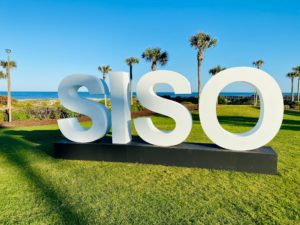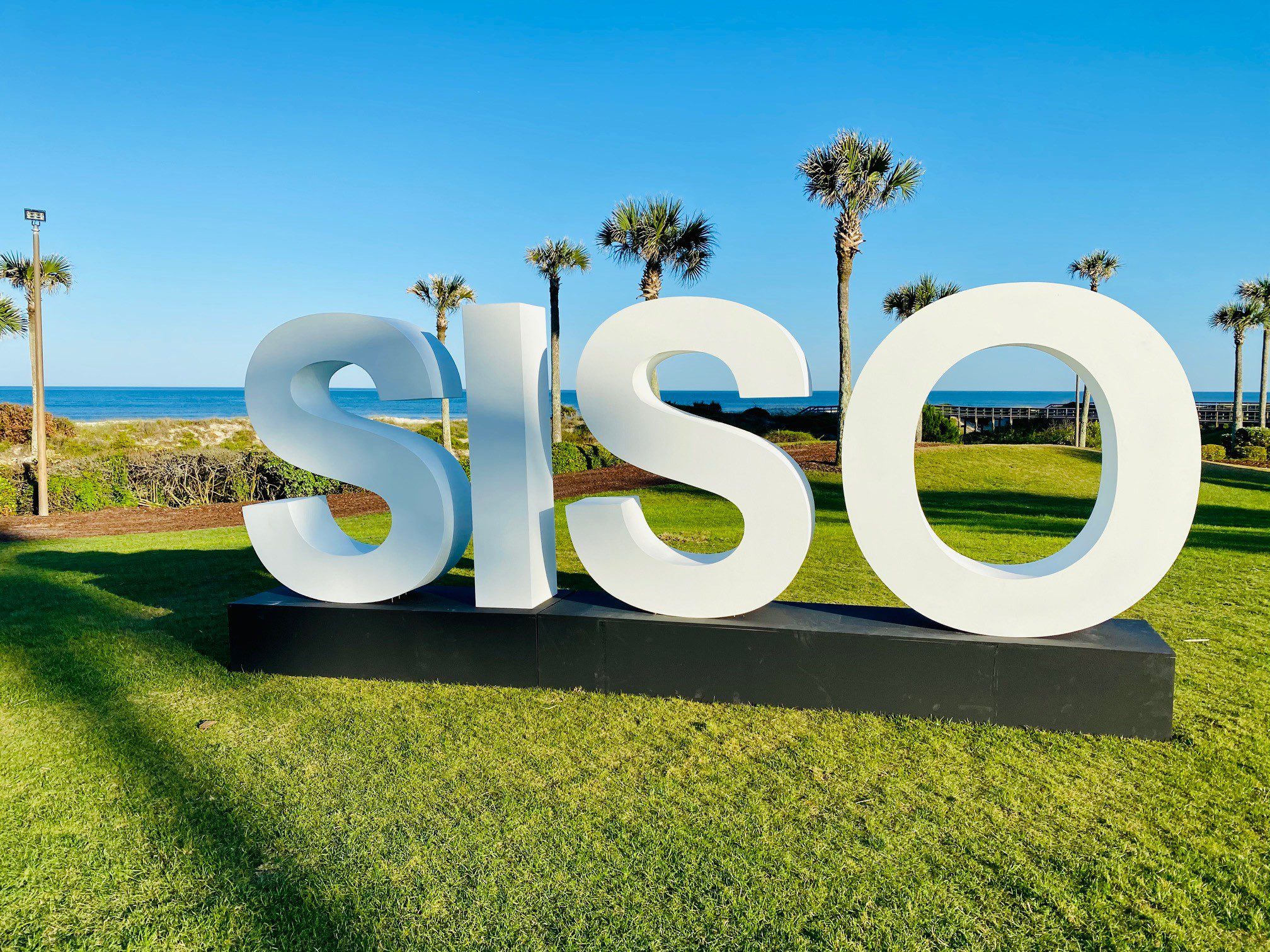
2021 SISO CEO Summit Event Signage
I have attended industry events for most of my life. In good and bad times, even after industry-influencing events such as 9/11 and the great recession. This was different. Not only was this arguably the very first large industry event in person, but it was also the first time in a year that many of us have traveled outside of our homes or pandemic pods to discuss event industry trends.
Like caged birds, we were finally allowed to fly and sing again. We were among our peers, our events professional tribe – all having suffered both personal and professional losses due to COVID. With more than 200 plus C-level show organizers and industry partners gathered on Amelia Island, Florida – one thing was clear, everyone wanted to solve how to move forward, grow stronger and evolve our industry.
While I shared my five lessons learned from a post-pandemic in-person event in my recent blog post, this post briefly covers the some of the key themes and trends from the SISO CEO Summit.
Partners Over Platforms
Industry leaders and show organizers equally agreed that event technology evolved rapidly over the past year. And while this explosive growth (from in and outside of the space) has offered some solutions to the challenges of the pandemic – selecting technology partners (and not just vendors) will be critical in the year ahead. Partners will need to evolve and navigate this new journey together, helping to develop new best practices and products that match the unique needs of event organizers and all the various audiences involved in successful events. Many of these needs will need to help address a 365-day, media and content-rich approach to engagement in addition to a more dynamic in-person experience. Not only will partners need to help serve the market, but revenue will also be a primary driver as events rebound and rebuild.
Engagement is the New Currency (Data/Digital/Dollars)
Engagement is the digital currency show organizers must build to connect and attract their audiences through modern media (live, digital and social media) on a more frequent basis than ever before. Webinars, content, hosted buyer programs, lead generation activities, activations, etc., will surround in-person events to keep audiences connected. As those channels build and evolve, the data and information around those interactions will further guide in-person and digital experiences.
Trade in the Virtual Space
Connecting buyers and suppliers and generating the equivalent revenue or sales leads in the virtual space has been one of the most significant challenges expressed by organizers over the past year. Even with improving technology solutions, replicating large-scale tradeshows in the digital space has not been incredibly successful for participants. This is especially challenging for exhibitors who have highly tactile or sense-driven products. For organizers who had recently staged in-person events, the responses were overwhelming that exhibitors and their prospective buyers viewed the events as critical for their business and that buyers had a much higher sense of purpose in connecting again with exhibitors in-person.
International Audiences
Much like the SISO event that would have typically seen another 100-plus registrants from members worldwide, the international landscape remains far more uncertain as restrictions prevent some international travel. Events that rely on both attendees and exhibitors/sponsors from international locations will need to help each audience navigate the changing landscape. SISO CEO did have two international attendees who could justify the conference as highly relevant to their business’s needs and attended. Organizations will have to consider how to help this audience or serve it effectively in the virtual format for the near term.
Challenging Assumptions
Leaders stressed that planning for the years ahead based on historical data would challenge every event and organization. The consensus was that 2019 should be considered an indicator and not a predictor. Many C-Level executives argued that 2022 or 2023 would be the first post-pandemic years to begin baseline benchmarking again. One major event organization shared with their reduced staffing they were having their team focus on operational milestones and goals versus financial ones given the uncertainty.
An Episodic Approach to Events Revenue
Once considered a reliable income for organizations, events became an uncertain and unpredictable activity in 2020. This episodic model (single, one-time events as the primary revenue driver) is now replaced with subscription models, marketplaces, online event communities and various year-long engagement activities to diversify revenue streams across their portfolios. Even in the mergers and acquisitions space, events are now viewed more regarding their engagement ability and events revenue.
Customer First Approach
Regardless of the format (in-person, virtual or hybrid), the agreement was that listening to the customer, including attendees and exhibitors/sponsors was critical as the industry rebuilds. Understanding their motivations, needs, pain points, etc. would help organizers build a more holistic approach to planning their events since many of these buyer considerations have drastically changed in the past year and will likely continue to evolve.
Events Employee Landscape
The layoffs and furloughs were considerable for many event industry partners. Most organizations openly shared they were entering a “new unknown” as events begin to stage in-person and hybrid. Few, if any, had their entire staff hired back and many were not in a position to rehire or only planning to slowly higher back a percentage of their pre-pandemic workforce – if they could find them. Understandably, many event professionals have moved outside of the industry for work.
There was a palpable concern that the entire ecosystem will be strained in Q3 and Q4 of this year with new event formats, compression in certain cities/venues and the ability to rely on a seasoned workforce. The positive news that many organizations were moving forward with events that would create the demand for every partner to reengage the workforce. It was also evident that retraining, retooling and building new roles to reflect the post-pandemic event will define the landscape for some time to come.
Engagement over Marketing Managers
With the significant initiative for more events engagement, executives considered re-thinking their marketing groups teams as engagement teams. These professionals are already heavily engaged in marketing to their various audiences using many platforms suited for this new engagement. They are reimagining these teams to adapt to these changing dynamics while utilizing existing resources more quickly.
Innovation – Creating Want to Attend Events
Innovation didn’t just apply to event technology or draw inspiration from the closing keynote speaker, George Blankenship . He helped architect Apple Computer’s brand-building retail strategy and revolutionized the car-buying experience as an executive at Tesla Motors. Innovation was a common thread throughout discussions and panels as executives felt as if the time had come to innovate at every level – from event operations to marketing – modernizing to meet the needs of the changed consumer behavior. This is further reinforced by a recent McKinsey and Company study found that found 90% of executives said they expect the fallout from COVID-19 to fundamentally change the way they do business over the next five years.
Bullish Event Industry Outlook
Anirban Basu, Chairman & Chief Executive Officer of Sage Policy Group, Inc. delivered compelling data showing indicators that a desired “V-shaped” recovery will provide a quicker ramp to revenue growth in 2021. He also shared that some industries (such as the hospitality and travel industry) will be slower to grow, given the profound impact this past year has had. Consumer sentiment continues to rise and consumer travel will rebound shortly after that.
Executives echoed sentiments as initial in-person events and customer surveys show both pent-up demand and a desire to return to in-person events. Customers and consumers are anxious to meet again in a face to environment. We are creatures of habit.
What’s Next in the Event Industry
Like all great events, it was hard to leave for many reasons. First, my head was filled with many new ideas and lessons learned – I didn’t want the learning to stop—the reason why organizers are considering event communities to continue the engagement year-round. Second, the event challenged and reconfirmed my belief on the approach I shared hybrid events will take in the coming years. And finally, it reconfirmed my love of an industry that will continue to evolve and rise from the ashes like a phoenix. With innovation and the focus on the customer, creating “Want to Attend” (versus must attend) events will drive the industry back to profitability and long-term growth. Here is looking forward to SISO Summer!

